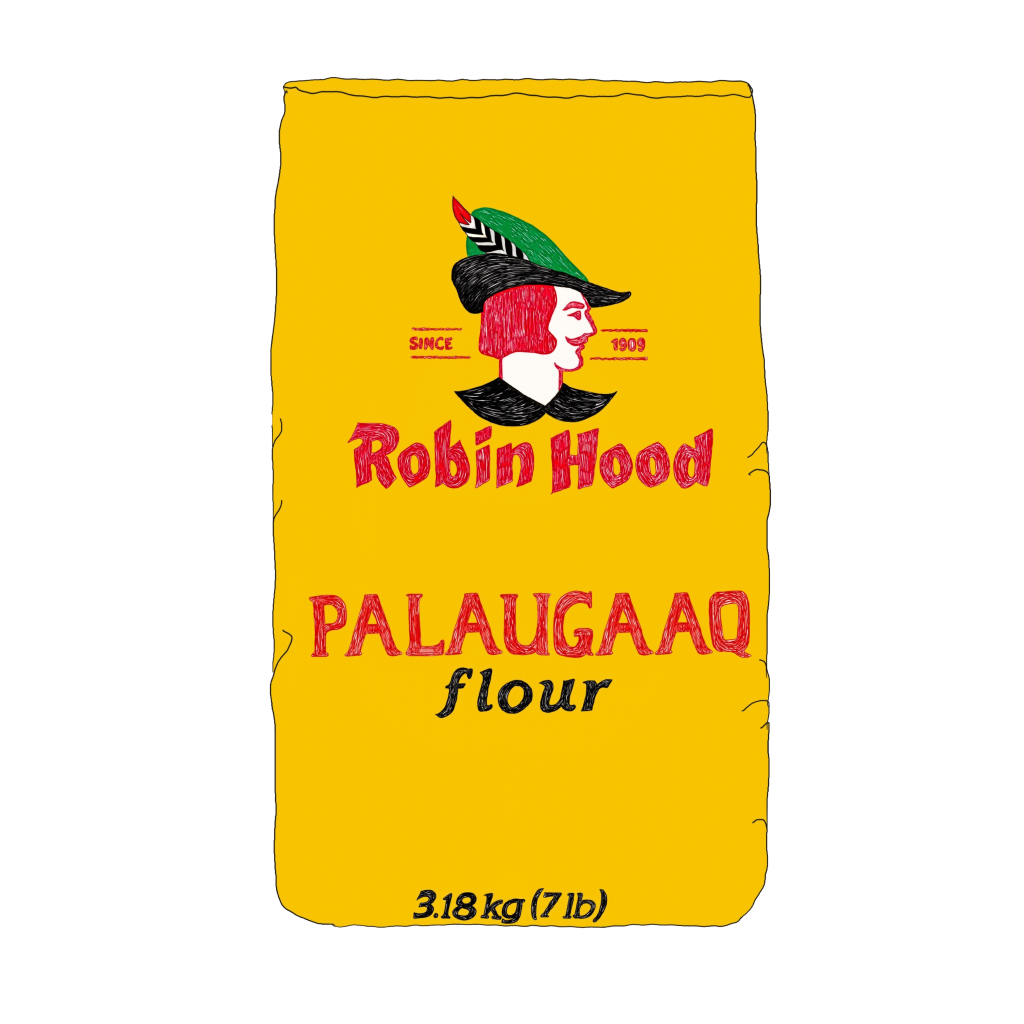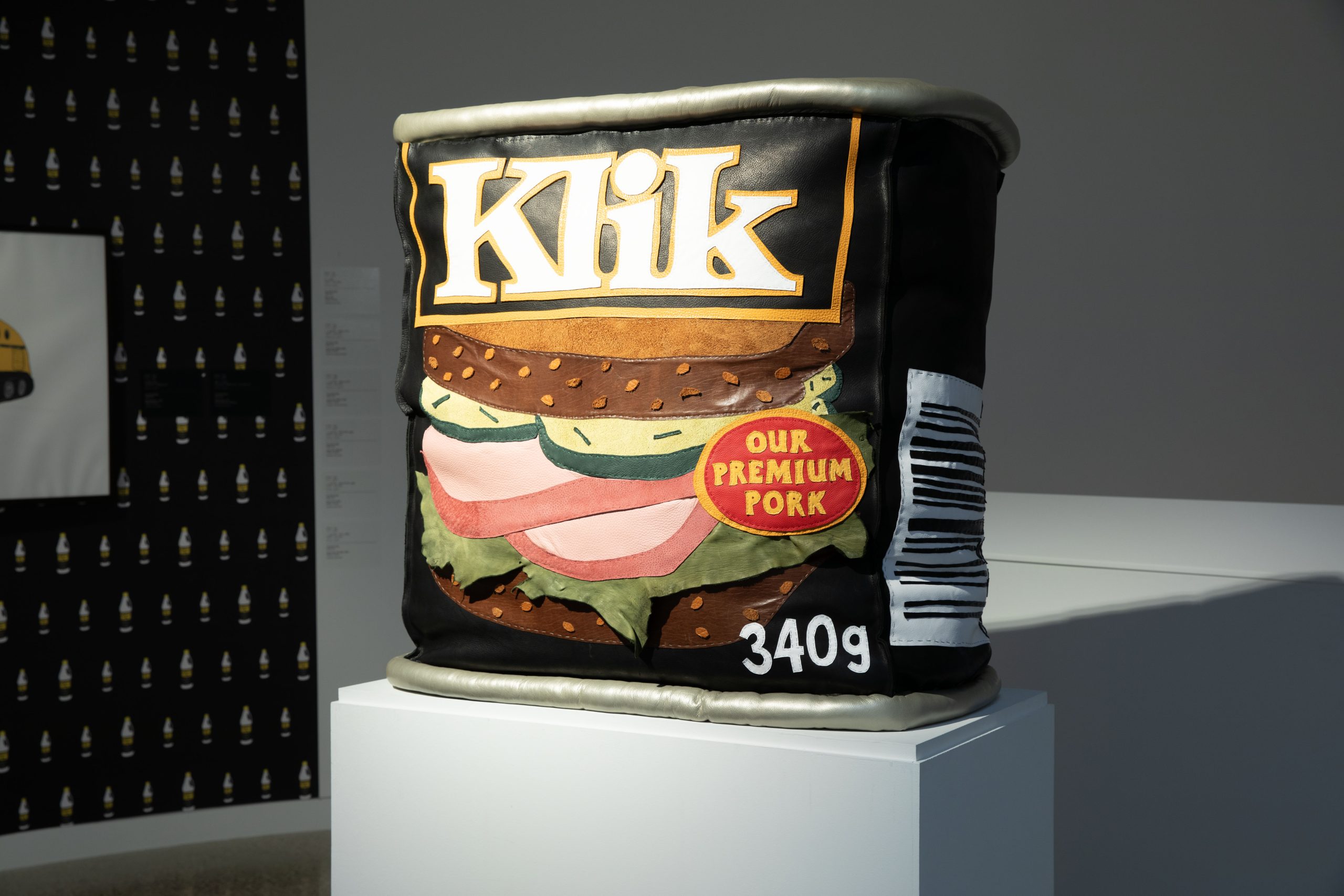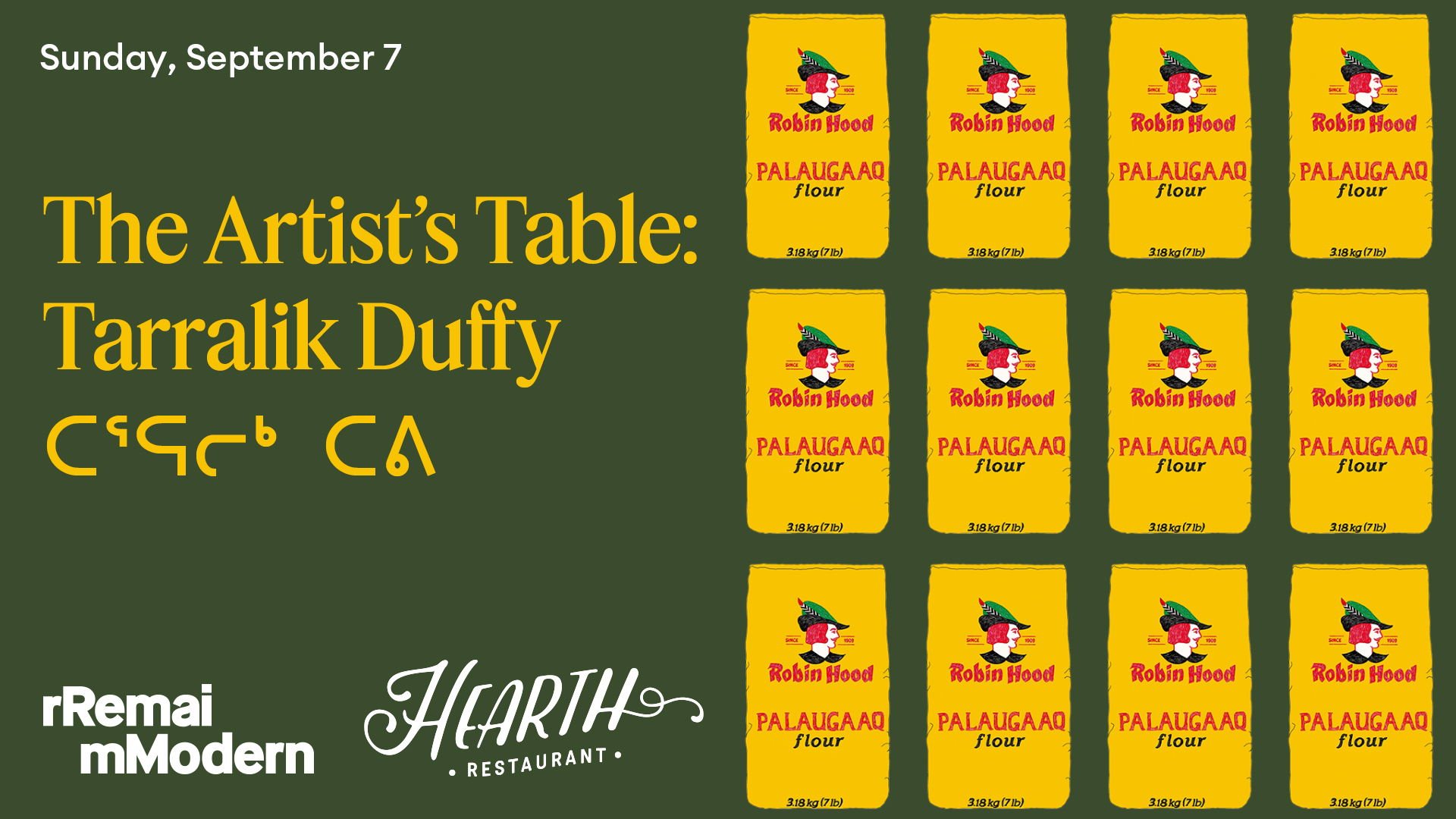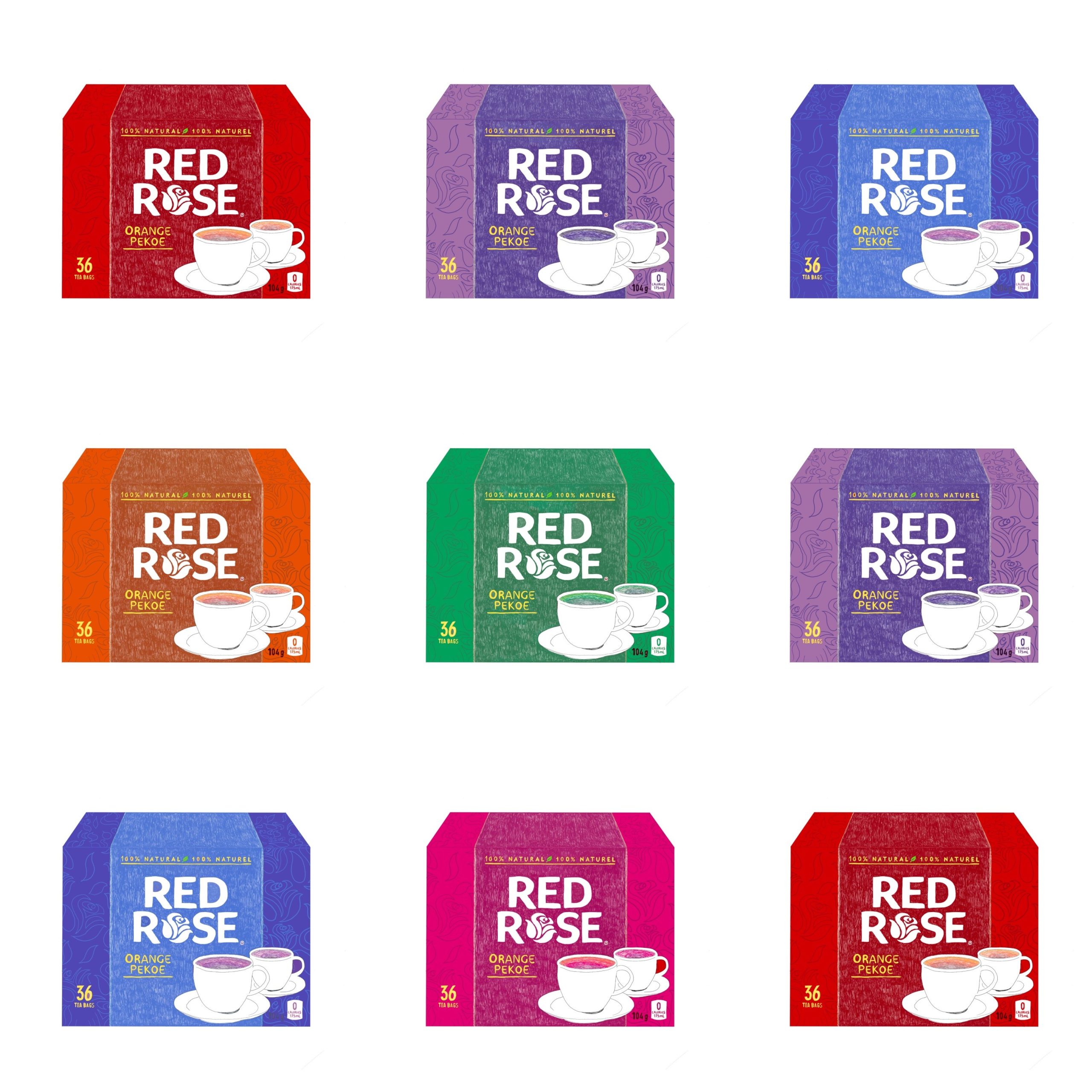Tarralik Duffy:
Klik My Heels
Tarralik Duffy’s art reflects themes of home, longing, and the complex beauty of everyday life in the North. Klik My Heels, her first solo exhibition in Saskatchewan, features recent digital drawings and soft sculptures that evoke personal and collective cultural memories, tracing her journey from Salliq (Coral Harbour), NU to Saskatoon, SK, where she now resides.
ᑕᕐᕋᓕᒃ ᑕᕕ ᑕᑯᓐᓈᒐᒃᓴᖏᑦ ᑕᑯᑎᑦᓯᕙᒃᐳᕐᓗ ᐅᕙᒍᒋᐅᔪᓂᒃ, ᐱᔪᒪᖃᑦᑖᕐᓂᐅᔪᓂᒃᒡᓗ ᐊᒻᒪᓗ ᐱᔭᕆᐊᑐᓂᐅᔪᓪᓗ ᐱᕌᕐᔫᔪᓂᒃ ᐅᑉᓗᑕᒫᑦ ᐃᓅᓯᕆᔭᑉᑎᖕᓂ ᐅᑭᐅᖅᑕᖅᑐᒥ. ᑲᓱᑲᑦᑕᕐᓗᒋᑦ ᑭᒻᒦᒃᑲ, ᓯᕗᓪᓕᖅᐹᖑᑉᓗᓂ ᑭᓯᕐᒥᐅᖅᖢᓂ ᑕᐅᑐᕋᓐᓇᒐᒃᓴᖓ ᓵᔅᑳᑦᑐᕚᓐᒥ, ᑕᑯᒃᓴᐅᑎᑦᓯᕗᕐᓗ ᐱᐊᓂᓵᓚᐅᒐᐃᓐᓂᒃ ᖃᕆᑕᐅᔭᒃᑯᑦ ᑎᑎᕋᐅᔭᓚᐅᒐᐃᓐᓂᑦ ᐊᒻᒪᓗ ᐊᕿᑦᑐᓂᒃ ᓴᓇᓐᖑᐊᒃᑲᑦ ᐃᑦᖃᐃᑎᑦᓯᔪᓂᒃ ᓇᒻᒥᓂᖅ ᐊᒻᒪᓗ ᑲᑎᑎᖅᓯᒪᑉᓗᑎᒃ ᐃᓕᖅᑯᓯᐅᔪᓂᒃ ᐃᑦᖃᐅᒪᔭᒃᓴᓂᒃ, ᓇᓗᓇᐃᖅᓯᓯᒪᔪᓂᒃ ᐊᐅᓪᓛᕐᓂᖓᓐᓂ ᓴᓪᓕᕐᒥ, ᓄᓇᕘᒥᑦ ᓵᔅᑲᑦᑑᓐᒧᑦ, ᓵᔅᑳᑦᓯᕚᓐᒧᑦ, ᐅᕙᒍᒋᓕᒑᓐᓂ.
Duffy’s work often focuses on household items that arrived in Inuit communities through colonial import—staples like flour, tea, baking powder, and canned goods. She describes this process as being ‘colonized by condiments,’ a wry observation that underscores the disruptive impact of these products on traditional hunting and fishing practices, as well as their lasting health consequences. Rendered as oversized soft sculptures in leather or as brightly coloured, often repeating prints, Duffy transforms these pantry staples into cultural icons. Their familiarity in northern communities echoes how 20th-century pop artists celebrated and critiqued American culture through mass-produced items. Yet, unlike the universally shared consumer culture those artists assumed, Duffy’s works carry distinct personal, cultural, and historical meaning. In her hands, these items become more than everyday products—they are love letters to home. Each work evokes her memories of growing up in Salliq in the 1980s, when southern pop culture mingled with the rise of Inuit self-representation in media.
ᑕᕕ ᐱᓕᕆᐊᕆᔭᖏᑦ ᑐᕌᖓᓗᐊᖅᑕᖅᐳᓪᓗ ᐃᒡᓗᕐᔫᑉ ᐃᓗᓕᖏᓐᓂᒃ ᑎᑭᑦᑕᓚᐅᖅᑐᓂᒃ ᐃᓄᐃᑦ ᓄᓇᖏᓐᓄᑦ ᖃᑉᓗᓈᑦ ᑎᑭᑦᑕᕆᐊᓕᖅᑎᓪᓗᒋᑦ ᑎᑭᐅᑎᔭᐅᕙᓚᐅᖅᑐᓂᒃ −ᐆᒃᑑᑎᒋᓗᒋᑦ ᓂᕿᒋᔭᐅᒐᔪᑦᑐᑦ ᐊᑦᒋᒃᓴᓂᒃ, ᑏᓂᒃ, ᐃᓚᒃᓴᑦ ᐊᒻᒪᓗ ᐃᐳᐃᑦᑐᑦ. ᑖᑉᑯᓂᖓᓗ ᐃᓱᒪᒋᓯᒪᕙᓗ ᐅᖃᐅᓯᕆᑉᓗᓂᒋᓪᓗ “ᖃᑉᓗᓈᖅᑕᓂᑦ ᑎᐱᓕᖅᑐᒐᐅᔪᓂᒃ ᒪᒪᖅᓴᐅᑎᓂᒃ.” ᑖᑉᑯᓂᖓᓗ ᐸᓂᖅᑑᓇᓱᒋᑉᓗᓂᒋᑦ ᖃᐅᔨᓴᕐᓂᕆᓚᐅᖅᐸᐃᓪᓗ ᑖᑉᑯᐊᓗ ᐊᒃᑐᐃᓂᖃᑦᓯᐊᖏᑕᐃᓐᓇᖅᑐᓪᓗ ᐃᓕᖅᑯᓯᑐᖃᐃᑦ ᐊᖑᓇᓱᐊᕐᓂᖏᓐᓂ ᐃᖃᓪᓕᐊᕐᓂᕐᒥᒡᓗ, ᐊᒻᒪᑦᑕᐅᖅ ᐊᑯᓂ ᑎᒥᒥᒍᑦ ᐋᓐᓂᐊᕐᓂᖏᓐᓂᒃ. ᐊᖏᔫᑦᑐᐃᑦ ᓴᓇᓐᖑᐊᒃᑲ ᕿᓯᐅᔭᒥᑦ ᐅᕙᓘᓐᓃᑦ ᖃᐅᒪᔫᓂᒃ ᖄᖏᑦᓐᓂᑦ, ᐊᒥᓱᐃᖅᑕᖅᓗᑎᒃ ᐊᔾᔨᒌᒃᑐᑦ ᒥᖑᐊᓐᖑᐊᒃᑲᑦ. ᑕᕕ ᐊᓪᓚᓐᖑᐃᑎᑦᓯᕗᕐᓗ ᑖᑉᑯᓂᖓ ᓂᖀᑦ ᓂᖃᐅᓯᕕᖕᒥᓐᖓᖅᑐᓂᒃ ᐃᓕᖅᑯᓯᐅᔪᓂᒃ ᑕᑯᒃᓴᐅᔾᔪᑎᒃᓴᓄᑦ. ᐃᓕᑕᕆᔭᐅᕙᒃᑐᑦ ᐅᑭᐅᖅᑕᖅᑐᒥ ᓄᓇᓕᐅᔪᓂ ᐊᔾᔨᐊᓂᒃ ᓂᑉᔮᖅᑎᑦᓯᕗᕐᓗ ᐅᑉᓗᒥᑎᑐᑦ ᐃᒻᖏᖅᑎᐅᔪᓂᒃ ᑎᑕᒃᑕᕐᓂᖏᖢᑎᓐᓂᒡᓗ ᖁᕕᐊᓲᑎᖃᖅᐸᓚᐅᖅᐳᓪᓗ ᐊᒻᒪᓗ ᐅᖃᐅᓯᖃᒥ ᐊᑦᑐᐊᖅᖢᑎᒡᓗ ᐊᒥᐊᓕᑲᑉ ᐃᓕᖅᑯᓯᖏᓐᓂ ᐊᒥᓱᕐᔪᐊᓂᒃ ᓴᓇᓯᒪᑎᓪᓗᒋᑦ. ᑭᓯᐊᓂ ᑖᑉᑯᐊᑎᑐᑦ ᐊᔾᔨᒌᒃᑯᓗᐊᒥᐊᑦᑐᐊᓂᒃ ᓂᐅᕕᖅᑕᐅᕙᒃᑐᓂᒃ ᐃᓕᖅᑯᓯᖏᓐᓂᒃ ᐃᒻᖏᖅᑎᕋᐃᑦ ᐱᒋᓐᓂᒃ, ᑖᒻᓇ ᑕᕕ ᐱᓕᕆᐊᕆᕙᒃᑕᖏᑦ ᐊᔾᔨᐅᖏᑦᑐᓂᒃ ᓇᒻᒥᓂᕐᒥᒃᓂ, ᐃᓕᖅᑯᓯᓂᒃ, ᐊᒻᒪᓗ ᑭᖑᕚᒥᓂᒃᑕᐅᖅ ᑐᑭᓕᖕᒥᒃ ᐱᖃᖅᐳᓪᓕ. ᐊᑦᒐᒥᓂᒃ, ᑖᑉᑯᐊ ᐅᑉᓗᑕᒫᑦ ᐊᑐᒐᐅᕙᒃᑐᓂᒃ ᐊᒡᓚᑦ ᐅᖓᑕᐅᑦᓯᕙᒃᐳᕐᓗ − ᑎᑎᕋᖅᑕᐅᓯᒪᔪᓂᒃ ᓇᒡᓕᒍᓱᒃᑐᓂᒃ ᑎᑎᖅᑲᑎᑐᑦ ᐃᑦᐳᓪᓗ ᐅᕙᒍᒥᓅᑦ, ᐱᓕᕆᐊᕆᔭᖏᓪᓗ ᐃᑦᖃᐅᒪᔭᒥᓂᒃ ᑕᑯᒃᓴᐅᑎᑦᓯᕗᕐᓗ ᐱᕈᖅᓴᖅᑎᓪᓗᒍ ᓴᓪᓕᕐᒥ 1980ᓂᑦ ᐊᓪᕌᒎᔪᓂ, ᑖᑉᑯᐊ ᖃᑉᓗᓈᑦ ᓄᓈᓐᓂᓐᖔᖅᓯᒪᔪᑦ ᐃᒻᖏᖅᑎᐅᔪᑦ ᐃᓕᖅᑯᓯᕆᔭᐅᔪᑦ ᑲᑎᑦᓯᕙᓪᓕᐊᑎᓪᓗᒋᑦ ᐱᒋᐊᖅᐸᓪᓕᐊᑎᓪᓗᒋᓪᓗ ᐃᓄᐃᑦ ᓇᒻᒥᓂᖅ ᑕᑯᒃᓴᐅᑎᑦᓯᓂᖏᓐᓂᒃ.
The exhibition’s title references two soft sculptures: Klik (2023), the canned luncheon meat, and a pair of kamiik (Inuktitut for “boots”) made from red leather. Echoing the ruby slippers from The Wizard of Oz, Duffy’s kamiik similarly symbolize magic, belonging, transformation, and inner strength. Unlike the imported goods she reclaims as cultural objects, however, these kamiik originate from home, drawing inspiration from her mother’s red leather high heels, her father’s kamiik, and patterns shared by relatives and women in her community.
ᑕᑯᕋᓈᒐᐅᔪᒃᓴᑦ ᓇᓗᓇᐃᖅᑕᐅᓯᒪᔪᓪᓗ ᒪᓪᕈᐃᓂᒃ ᓴᓇᓐᖑᐊᒃᑲᓂᒃ ᐊᕿᑦᑑᔪᓂᒃ: ᑲᓱᑲᑦᑕᕐᓂᖅ 2023, ᐃᐳᐃᑦᑑᔪᖅ, ᐊᒻᒪᓗ ᑲᒦᒃ (ᐃᓄᒃᑎᑐᑦ “ᐊᒫᓘᒃ ᓴᓇᔭᐅᓯᒪᕗᓪᓗ ᐊᐅᐸᓗᒃᑐᒥᒃ ᕿᓯᐅᔭᒥᑦ. ᐊᔪᖃᖅᓯᑉᓗᓂᓗ ᐊᐅᐸᓗᒃᑑᓂᒃ ᐱᓂᕋᕐᓂᒃ ᑕᕐᕆᔭᐅᒻᒥᑦ ᕕᓱᕐᑦ ᐊᕙ ᐋᔅ, ᑕᐱᑉ ᑲᒥᖏᒃ ᐃᓱᒪᒋᔭᐅᓯᒪᕙᐃᓗ ᐊᖓᒃᑯᐊᕿᓂᕐᒥᒃ, ᖃᐅᔨᒪᓂᕐᒥᒡᓗ ᐃᓚᐅᓯᒪᓂᕐᒥᒃ, ᐊᓪᓚᓐᖑᐃᓂᖅ, ᐊᒻᒪᓗ ᐃᓗᑉᑯᑦ ᓴᓐᖏᓂᕐᒥᑦ. ᑕᐃᑉᑯᐊᑎᑐᑦ ᐱᓐᖏᒃᖢᓂ ᑎᑭᓴᖅᑕᐅᓐᓂᑯᑦ ᐃᓱᒪᒋᓯᒪᕙᐃᓗ ᐃᓕᖅᑯᓯᓄᑦ ᐱᖁᑎᑦ, ᑭᓯᐊᓂᑉᑕᐅᖅ, ᑖᑉᑯᐊ ᑲᒦᒃ ᓇᒥᖔᖅᓯᒪᖕᒪᖔᑦ ᐱᓯᒪᕗᓪᓕ, ᖁᕕᐊᓇᖅᑐᓂᒃ ᐃᓱᒪᒋᔭᖃᕐᖢᓂ ᐊᓈᓈᑕ ᐊᐅᐸᓗᒃᑐᒃ ᕿᓯᐅᔭᓂᒃ ᕿᒻᒥᕋᐅᔭᖏᓐᓂᒃ, ᐊᑖᑕᓗ ᑲᒥᖏᓐᓂᒃ, ᐊᒻᒪᓗ ᐊᔪᖃᖅᓯᔭᒃᓴᓂᒃ ᐆᒃᑐᑎᓂᒃ ᐃᓚᒋᔭᒥᖕᓂᒃ ᐊᒻᒪᓗ ᐊᕐᓇᓂᑦ ᓄᓇᓕᒋᔭᒥᖕᓂ.
Expanding on themes of home, family, and cultural knowledge, the exhibition also highlights works that reflect shared histories. An image of a Robin Hood Flour bag pays homage to the mill in Saskatoon while replacing the words “All Purpose” with “Palaugaaq,” which means bannock in Inuktitut. Introduced alongside the forced displacement of Inuit from their lands and food sources, wheat flour became part of a complex history. Over generations, however, palaugaaq has been lovingly prepared and shared, with recipes celebrated as sources of pride and cultural connection. This staple food connects Indigenous communities from the prairies to the tundra, mirroring how the exhibition at Remai Modern bridges Duffy’s two homes of Salliq and Saskatoon. Similarly, as palaugaaq represents sustenance, adaptation and persistence for Inuit, Duffy’s work likewise embraces and transforms everyday elements into expressions of cultural strength and endurance.

ᐃᓚᒋᐊᕐᓂᖃᖅᖢᒍ ᐊᒥᓱᓐᖑᖅᐹᓪᓕᖁᑉᓗᒍ ᓇᑭᓐᖔᖅᓯᒪᓂᖓᓐᓂ, ᐊᒻᒪᓗ ᐃᓕᖅᑯᓯᖓᑕ ᖃᐅᔨᒪᓂᖓᓂᒃ, ᑕᑯᕋᓈᒐᐅᔪᒃᓴᑦ ᑕᑯᒃᓴᐅᓂᖃᑦᓯᐊᖅᐳᕐᓗ ᐊᒥᖅᑳᒐᐅᓯᒪᔪᓂᒃ ᖃᓄᐃᓐᓂᖏᓐᓂᒃ ᓇᑭᓐᖔᕐᓂᖏᓐᓂᒃ. ᐊᑦᒋᒃᓴᑦ ᖁᖅᓱᖅᑐᒥᒃ ᐴᓖ% (ᕌᐱᓐ ᕼᐳᑦ) ᓇᓗᓇᐃᖅᓯᓯᒪᑦᓯᐊᖅᐳᕐᓗ ᓴᓇᕝᕕᒋᔭᐅᔪᒥᒃ ᓵᔅᑳᑦᑐᕚᓐᒥ ᐃᓇᖐᓯᒪᑉᓗᑎᒃ “ᑕᒪᐃᓐᓄᑦ” ᐆᒧᖓᖅᖠᖅ “ᐸᓚᐅᒑᖅ”, ᑐᑭᓕᖕᒥᒃ ᐊᓚᒃᓴᐅᔮᖅᑐᒥᒃ ᐃᓄᒃᑎᑐᑦ. ᐅᖃᐅᓯᖃᖅᖢᑎᒡᓗ ᓴᓂᐊᓂ ᐃᓱᒪᖅᓱᖅᑎᑕᐅᓐᖏᒃᖢᑎᒃ ᓄᒃᑎᖅᑐᖅᑎᑕᐅᒥᐊᕐᓂᖏᓐᓂᒃ ᐃᓄᐃᑦ ᓄᓈᓐᓂᑦ ᐊᒻᒪᓗ ᓂᖃᐅᑎᖏᓐᓂᑦ, ᑖᑉᑯᐊ ᐊᓚᒃᓴᐅᔮᖅᑐᑎ ᐱᔭᕆᐊᑐᔪᒥᒃ ᐃᓂᖃᕐᓂᑰᓯᒪᕗᓪᓗ ᓇᑭᓐᖔᕐᓂᖏᓐᓂᒃ. ᖓᒥᓱᓪᓗ ᐊᓪᐹᒍᒌᑦ ᐃᓄᐃᑦ, ᑭᓯᐊᓂ, ᐸᓚᐅᒑᖅ ᓂᒡᓕᖕᓂᒃᑯᑦ ᐃᒐᔭᐅᓯᒪᕙᕐᓗ ᐊᒻᒪᓗ ᐊᒥᖅᑳᒐᐅᑉᓗᓂᓗ, ᖃᓄᕐᓗ ᐃᒐᔭᐅᓱᕐᒪᖔᑖ ᐊᒥᖅᑳᒐᐅᑉᓗᑎᒃ ᖁᕕᐊᓲᑎᒋᔭᐅᑉᓗᓂᓗ ᐊᒻᒪᓗ ᐃᓕᖅᑯᓯᐅᔪᒃᑕᐅᖅ ᑲᑎᑎᑦᓯᕙᒃᖢᓂᓗ. ᑖᒃᑯᐊ ᓂᖀᑦ ᑲᑎᑎᑦᓯᕙᒃᐳᕐᓗ ᓄᓇᖃᖅᑳᖅᑐᕕᓂᕐᓂᒃ ᓄᓇᓕᐅᔪᓂᒃ ᑕᐃᑲᓐᖑᑦ ᑲᖏᒥᑦ ᓄᓇᐃᓐᓇᕐᒧᓪᓗ, ᐊᔾᔨᒌᒃᑐᓂᒡᓗ ᑕᑯᒃᓴᐅᑎᑦᓯᑉᓗᓂᓗ ᒪᓪᕈᐃᓂᒃ ᓇᑭᓐᖔᖅᓯᒪᖕᒪᖔᓪᓗ ᓴᓪᓕᕐᒥ ᐊᒻᒪᓗ ᐅᑉᓗᒥᐅᓕᖅᑐᕐᓗ ᐅᕙᒍᒋᓕᖅᑕᒥᒃᓂ ᓵᒡᑳᑦᑐᕚᓐᒥ. ᐊᔾᔨᖅᑲᔭᐅᑉᓗᑎᒡᓗ, ᐸᓚᐳᒑᑦ ᐅᑯᓂᖓ ᓇᓗᓇᐃᖅᓯᓯᒪᑦᓯᐊᖅᐳᕐᓗ ᓂᖃᐅᖕᒪᑕ ᐃᒥᒐᒃᓴᐅᑉᓗᑎᒡᓗ, ᐊᓪᓚᓂᖅᑕᒧᓪᓗ ᐃᓅᓯᕐᒥᒃ ᐊᑐᖅᐸᓪᓕᐊᓂᕐᒧᑦ ᓈᒻᒪᒐᓱᐊᖅᖢᑎᒃ ᐊᒻᒪᓗ ᑲᔪᓯᓂᖃᑦᓯᐊᖅᓗᑎᒃ ᐊᓂᒐᐃᑦᓯᐊᖅᖢᑎᒡᓗ ᐃᓄᐃᑦ. ᑕᕕᑉ ᐱᓕᕆᐊᖏᑦ ᐊᔾᔨᐊᓂ ᐃᕿᑦᓯᕗᕐᓗ ᐊᒻᒪᓗ ᐊᓪᓚᓐᖑᐃᕗᕐᓗ ᐅᑉᓗᑕᒫᑦ ᐊᑐᒐᐅᕙᒃᑐᓂᒃ ᐅᖃᐅᓯᖃᑦᓯᐊᖅᖢᑎᒡᓗ ᐃᓕᖅᑯᓯᑦ ᓴᓐᖏᓂᖏᓐᓂᒃ ᐊᒻᒪᓗ ᐊᓂᒎᑎᑦᓯᐊᕐᓂᕐᒥᒡᓗ.
Event/Exhibition meta autogenerated block.
When
May 24, 2025 – October 12, 2025
Where
Connect Gallery
Artist Bio:
Tarralik Duffy is a writer, multidisciplinary artist, and designer from Salliq, Nunavut, now residing in Saskatoon, Saskatchewan. Much of her work centres on contemporary Inuit culture, and her experiences as an Inuk living between her Arctic island home and city life in the south. Duffy is the recipient of the 2021 Kenojuak Ashevak Memorial Award and is on the shortlist for the 2025 Sobey Art Award. Her work has recently been featured in solo exhibitions at the Art Gallery of Ontario, Toronto; SAW Nordic Lac, Ottawa; and the Winnipeg Art Gallery-Qaumajuq. An accomplished writer, her Inuit Art Quarterly essay on artist Jutai Toonoo was included in Best Canadian Essays 2019. She also received the Sally Manning Award in 2014 for her story “Don’t Cry Over Spilled Beads.” Through her jewellery label Ugly Fish, Duffy uses natural materials to craft designs exhibited across Canada and Europe, including at Paris Fashion Week.
ᑕᕕ ᑐᓂᔭᐅᓚᐅᖅᓯᒪᕗᕐᓕ 2021ᒥ ᕿᓐᓄᐊᔪᐊ ᐋᓯᕙᖕᒥᒃ ᐃᑦᖃᐅᒪᔾᔪᑎᒥᒃ ᑐᓂᔭᐅᓱᖅᑐᒥᒃ. ᐱᓕᕆᐊᕿᔭᖏᑦᑕ ᑕᑯᒃᓴᐅᑎᑕᐅᓚᐅᖅᐳᓪᓗ ᑭᓯᕐᒥᐊᖅᖢᑎᒃ ᑕᑯᕋᓐᓇᕐᕕᖕᒥ ᐊᓐᑎᐊᕆᔪᒥ, ᑐᕌᓐᑐᒥ, ᓵ ᓄᐊᑎᒃ ᓛᒃ, ᐊᑐᕚᒥ; ᐊᒻᒪᓗ ᕕᓂᐲᖕᒥ ᑕᑯᕋᓐᓈᕐᕕᖕᒥ−ᖁᒻᒧᐊᔪᖅ. ᐊᔪᓐᖏᑦᓯᐊᖅᑐᖅ ᑎᑎᕋᖅᑎ, ᐃᓄᐃᑦ ᑎᑎᕋᐅᓯᖏᑦ ᑎᑎᕋᓚᐅᒑᓗ ᔪᑕᐃ ᑐᓄᒥᒃ ᐃᓚᐅᖃᑕᐅᓚᐅᖅᐳᕐᓗ ᑎᑎᕋᖅᑕᐅᔪᓂᒃ ᐊᔪᓐᖏᓛᕐᓂᖏᓐᓂ 2019ᒥ. ᐱᑖᓚᐅᖅᐳᕐᓗ ᓵᓕ ᒫᓂᖕᒥᒃ ᐃᑦᖃᐅᒪᔾᔪᑕᐅᔪᒥᒃ ᑐᓂᔭᐅᓱᖅᑐᒥᒃ 2014ᖑᑎᓪᓗᒍ ᑎᑎᕋᐅᓯᕆᓚᐅᒑᓂᒃ “ᕿᐊᑦᑕᖏᓪᓗᑎᑦ ᑯᕕᓐᓂᑯᓂᒃ ᓱᖓᐅᔭᓂᒃ.” ᑕᐃᑰᓇ ᐅᔭᒥᕋᓗᐃᑦ ᒥᑭᓕᕋᕈᑎᑦ ᐊᑎᓕᖕᓂᑦ ᐃᓂᖁᓇᓐᖏᑦᑐᑦ ᐃᖃᓗᕐ, ᑕᕕ ᐊᑐᓚᐅᖅᐳᕐᓗ ᓴᓐᓂᖅᓯᒪᓐᖏᑦᑐᓂᒃ ᓴᓇᓐᖑᐊᒃᑲᓂᒃ ᑕᑯᒃᓴᐅᑎᑦᓯᑉᓗᓂᓗ ᑲᓇᑕᓗᒃᑖᒥ ᐊᒻᒪᓗ ᑕᕆᐅᑉ ᐊᑭᐊᓂ, ᐅᑯᐊᑉᑕᐅᖅ ᐃᓚᐅᖃᑕᐅᑉᓗᑎᒃ ᐱᐊᕆᔅ ᑕᑯᕋᓐᓈᒐᐅᔪᓂᒃ ᑕᑯᕋᓐᓂᖅᑐᑦᓯᐊᓂᒃ..
The artist would like to thank the Canada Council for the Arts, Inuit Arts Foundation and Kajungiqsaut Grants, and SK Arts for supporting this exhibition.
Tarralik Duffy: Klik My Heels is generously supported by SIGA.




